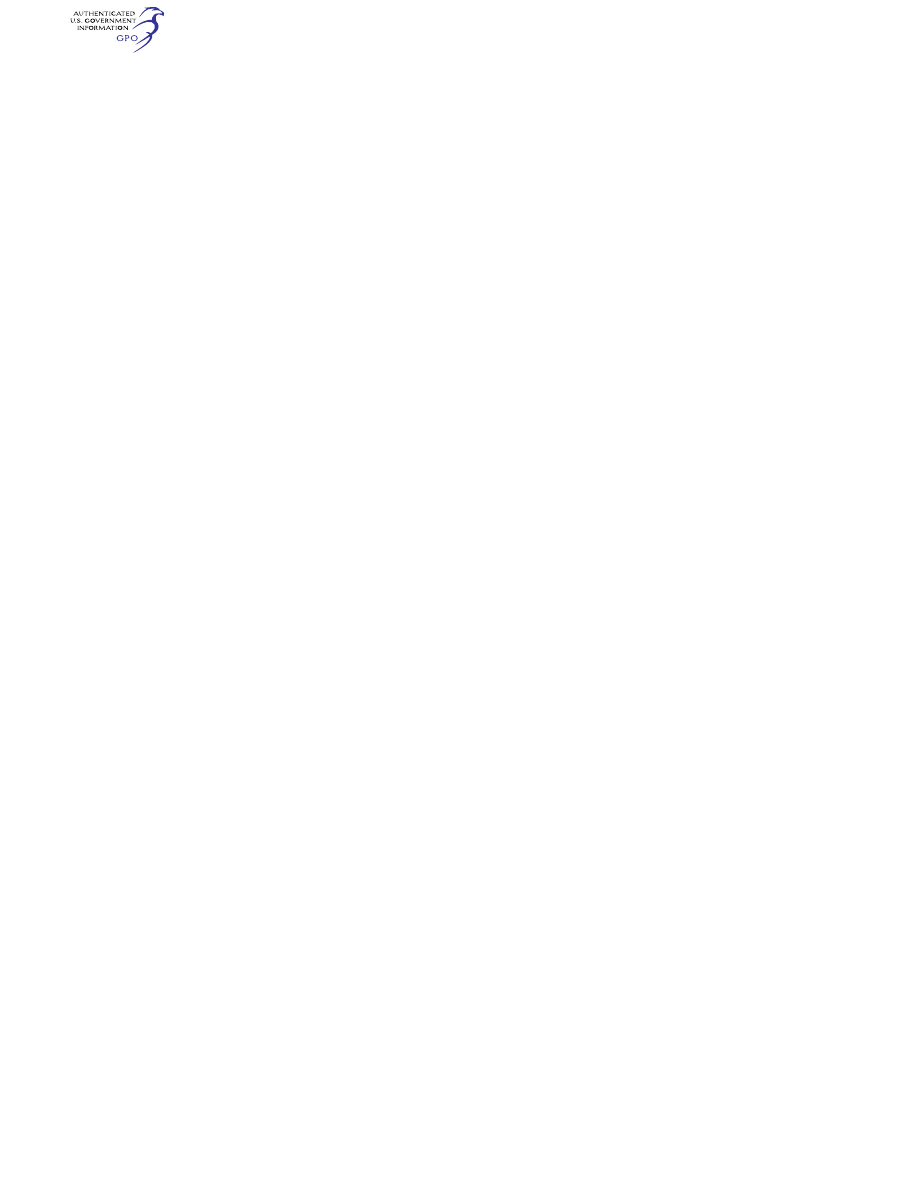
521
Federal Aviation Administration, DOT
§ 27.785
the cockpit structure or the pilot’s
clothing when pilots from 5
′
2
″
to 6
′
0
″
in
height are seated.
§ 27.779
Motion and effect of cockpit
controls.
Cockpit controls must be designed so
that they operate in accordance with
the following movements and actu-
ation:
(a) Flight controls, including the col-
lective pitch control, must operate
with a sense of motion which cor-
responds to the effect on the rotor-
craft.
(b) Twist-grip engine power controls
must be designed so that, for lefthand
operation, the motion of the pilot’s
hand is clockwise to increase power
when the hand is viewed from the edge
containing the index finger. Other en-
gine power controls, excluding the col-
lective control, must operate with a
forward motion to increase power.
(c) Normal landing gear controls
must operate downward to extend the
landing gear.
[Amdt. 27–21, 49 FR 44434, Nov. 6, 1984]
§ 27.783
Doors.
(a) Each closed cabin must have at
least one adequate and easily acces-
sible external door.
(b) Each external door must be lo-
cated where persons using it will not be
endangered by the rotors, propellers,
engine intakes, and exhausts when ap-
propriate operating procedures are
used. If opening procedures are re-
quired, they must be marked inside, on
or adjacent to the door opening device.
[Doc. No. 5074, 29 FR 15695, Nov. 24, 1964, as
amended by Amdt. 27–26, 55 FR 8001, Mar. 6,
1990]
§ 27.785
Seats, berths, litters, safety
belts, and harnesses.
(a) Each seat, safety belt, harness,
and adjacent part of the rotorcraft at
each station designated for occupancy
during takeoff and landing must be free
of potentially injurious objects, sharp
edges, protuberances, and hard surfaces
and must be designed so that a person
making proper use of these facilities
will not suffer serious injury in an
emergency landing as a result of the
static inertial load factors specified in
§ 27.561(b) and dynamic conditions spec-
ified in § 27.562.
(b) Each occupant must be protected
from serious head injury by a safety
belt plus a shoulder harness that will
prevent the head from contacting any
injurious object except as provided for
in § 27.562(c)(5). A shoulder harness
(upper torso restraint), in combination
with the safety belt, constitutes a
torso restraint system as described in
TSO-C114.
(c) Each occupant’s seat must have a
combined safety belt and shoulder har-
ness with a single-point release. Each
pilot’s combined safety belt and shoul-
der harness must allow each pilot when
seated with safety belt and shoulder
harness fastened to perform all func-
tions necessary for flight operations.
There must be a means to secure belts
and harnesses, when not in use, to pre-
vent interference with the operation of
the rotorcraft and with rapid egress in
an emergency.
(d) If seat backs do not have a firm
handhold, there must be hand grips or
rails along each aisle to enable the oc-
cupants to steady themselves while
using the aisle in moderately rough
air.
(e) Each projecting object that could
injure persons seated or moving about
in the rotorcraft in normal flight must
be padded.
(f) Each seat and its supporting
structure must be designed for an occu-
pant weight of at least 170 pounds con-
sidering the maximum load factors, in-
ertial forces, and reactions between oc-
cupant, seat, and safety belt or harness
corresponding with the applicable
flight and ground load conditions, in-
cluding the emergency landing condi-
tions of § 27.561(b). In addition—
(1) Each pilot seat must be designed
for the reactions resulting from the ap-
plication of the pilot forces prescribed
in § 27.397; and
(2) The inertial forces prescribed in
§ 27.561(b) must be multiplied by a fac-
tor of 1.33 in determining the strength
of the attachment of—
(i) Each seat to the structure; and
(ii) Each safety belt or harness to the
seat or structure.
(g) When the safety belt and shoulder
harness are combined, the rated
strength of the safety belt and shoulder
VerDate Sep<11>2014
09:06 Jun 28, 2024
Jkt 262046
PO 00000
Frm 00531
Fmt 8010
Sfmt 8010
Y:\SGML\262046.XXX
262046
jspears on DSK121TN23PROD with CFR

522
14 CFR Ch. I (1–1–24 Edition)
§ 27.787
harness may not be less than that cor-
responding to the inertial forces speci-
fied in § 27.561(b), considering the occu-
pant weight of at least 170 pounds, con-
sidering the dimensional characteris-
tics of the restraint system installa-
tion, and using a distribution of at
least a 60-percent load to the safety
belt and at least a 40-percent load to
the shoulder harness. If the safety belt
is capable of being used without the
shoulder harness, the inertial forces
specified must be met by the safety
belt alone.
(h) When a headrest is used, the head-
rest and its supporting structure must
be designed to resist the inertia forces
specified in § 27.561, with a 1.33 fitting
factor and a head weight of at least 13
pounds.
(i) Each seating device system in-
cludes the device such as the seat, the
cushions, the occupant restraint sys-
tem, and attachment devices.
(j) Each seating device system may
use design features such as crushing or
separation of certain parts of the seats
to reduce occupant loads for the emer-
gency landing dynamic conditions of
§ 27.562; otherwise, the system must re-
main intact and must not interfere
with rapid evacuation of the rotorcraft.
(k) For the purposes of this section, a
litter is defined as a device designed to
carry a nonambulatory person, pri-
marily in a recumbent position, into
and on the rotorcraft. Each berth or
litter must be designed to withstand
the load reaction of an occupant
weight of at least 170 pounds when the
occupant is subjected to the forward
inertial factors specified in § 27.561(b).
A berth or litter installed within 15
°
or
less of the longitudinal axis of the
rotorcraft must be provided with a pad-
ded end-board, cloth diaphram, or
equivalent means that can withstand
the forward load reaction. A berth or
litter oriented greater than 15
°
with
the longitudinal axis of the rotorcraft
must be equipped with appropriate re-
straints, such as straps or safety belts,
to withstand the forward load reaction.
In addition—
(1) The berth or litter must have a re-
straint system and must not have cor-
ners or other protuberances likely to
cause serious injury to a person occu-
pying it during emergency landing con-
ditions; and
(2) The berth or litter attachment
and the occupant restraint system at-
tachments to the structure must be de-
signed to withstand the critical loads
resulting from flight and ground load
conditions and from the conditions pre-
scribed in § 27.561(b). The fitting factor
required by § 27.625(d) shall be applied.
[Amdt. 27–21, 49 FR 44434, Nov. 6, 1984, as
amended by Amdt. 27–25, 54 FR 47319, Nov. 13,
1989; Amdt. 27–35, 63 FR 43285, Aug. 12, 1998]
§ 27.787
Cargo and baggage compart-
ments.
(a) Each cargo and baggage compart-
ment must be designed for its plac-
arded maximum weight of contents and
for the critical load distributions at
the appropriate maximum load factors
corresponding to the specified flight
and ground load conditions, except the
emergency landing conditions of
§ 27.561.
(b) There must be means to prevent
the contents of any compartment from
becoming a hazard by shifting under
the loads specified in paragraph (a) of
this section.
(c) Under the emergency landing con-
ditions of § 27.561, cargo and baggage
compartments must—
(1) Be positioned so that if the con-
tents break loose they are unlikely to
cause injury to the occupants or re-
strict any of the escape facilities pro-
vided for use after an emergency land-
ing; or
(2) Have sufficient strength to with-
stand the conditions specified in § 27.561
including the means of restraint, and
their attachments, required by para-
graph (b) of this section. Sufficient
strength must be provided for the max-
imum authorized weight of cargo and
baggage at the critical loading dis-
tribution.
(d) If cargo compartment lamps are
installed, each lamp must be installed
so as to prevent contact between lamp
bulb and cargo.
[Doc. No. 5074, 29 FR 15695, Nov. 24, 1964, as
amended by Amdt. 27–11, 41 FR 55469, Dec. 20,
1976; Amdt. 27–27, 55 FR 38966, Sept. 21, 1990]
§ 27.801
Ditching.
(a) If certification with ditching pro-
visions is requested, the rotorcraft
VerDate Sep<11>2014
09:06 Jun 28, 2024
Jkt 262046
PO 00000
Frm 00532
Fmt 8010
Sfmt 8010
Y:\SGML\262046.XXX
262046
jspears on DSK121TN23PROD with CFR

